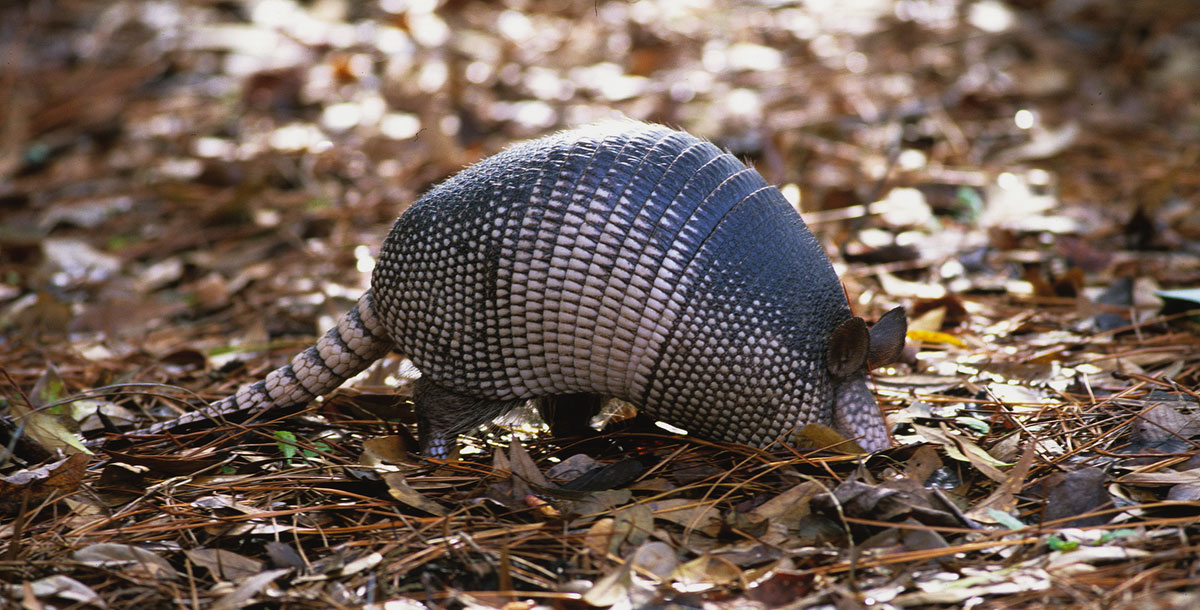
Nine-banded Armadillo. Photo by Michael Jeffords



Nine-banded Armadillo. Photo by Michael Jeffords
If you’ve spent any amount of time on Facebook, or looking through the Illinois outdoor news recently, you’ve likely seen a headline about an armadillo sighting in Illinois.
The 21 varieties of armadillos are suited to life in temperate and warm habitats because they lack the fat stores necessary to survive in colder climates. The nine-banded armadillo (Dasypus novemcinctus) has ventured the farthest north where some are enduring wintry temperatures.
The term armadillo is derived from a Spanish word meaning “little armored one,” referring to the bony plates covering its back, head, legs and tail. With strong legs and long claws, they dig burrows in which they spend nearly 16 hours each day, emerging in the morning and evening to feed. Possessing poor eyesight, armadillos rely on a keen sense of smell when hunting for food. Classified as an omnivore and found to eat small vertebrates, eggs, and some fruits and carrion, they primarily feed on a variety of insects, with an estimated 90 percent of their diet obtained by inserting their long, sticky tongue into a tunnel to collect ants, termites and beetles.
In the early 1800s, the nine-banded armadillo wasn’t found north of the Rio Grande River, but since the 1850s it has steadily advanced northward. By the 1920s armadillos were found in Louisiana, and from there they moved in to Arkansas and Mississippi, and then neighboring states. First documented in Illinois in 1979, the frequency of roadkills has increased since the 1990s. Since August 2013, Illinois Department of Natural Resources (IDNR) biologists have observed 272 armadillos. Today armadillos have been sighted as far north as Adams, Cook, Fulton, Kankakee, Macon, Sangamon and Vermilion counties. Armadillos continue to be most common in the lower 50 counties, and southwestern Illinois is considered the epicenter for the Illinois population. Armadillos are not protected by the Wildlife Code, meaning there are no restrictions on the take of animals.
How—are they crossing bridges, hopping railcars, swimming rivers or being moved by misguided humans—and why—does climate change and increasingly warmer winters ensure survival farther north—the armadillo range has expanded northward are scientific mysteries.

In July 2017, Dr. Agustin Jiménez and Dr. Eric Schauber with the Department of Zoology at Southern Illinois University-Carbondale initiated a Federal Aid in Wildlife Restoration project to study the ecology of nine-banded armadillos in Illinois, and ultimately provide IDNR with information to support agency programs. Included in the research will be the identification of travel corridors, estimation of the rates of dispersion, identification of suitable habitat and an inventory of the parasites Illinois armadillos possess. Details of this research will appear in a future Outdoor Illinois Wildlife Journal article.
Kathy Andrews Wright retired from the Illinois Department of Natural Resources where she was editor of OutdoorIllinois magazine. She is currently the editor of OutdoorIllinois Journal.
Submit a question for the author
Question: What do you now about the ancient armadillo found at Fogelpole Cave?